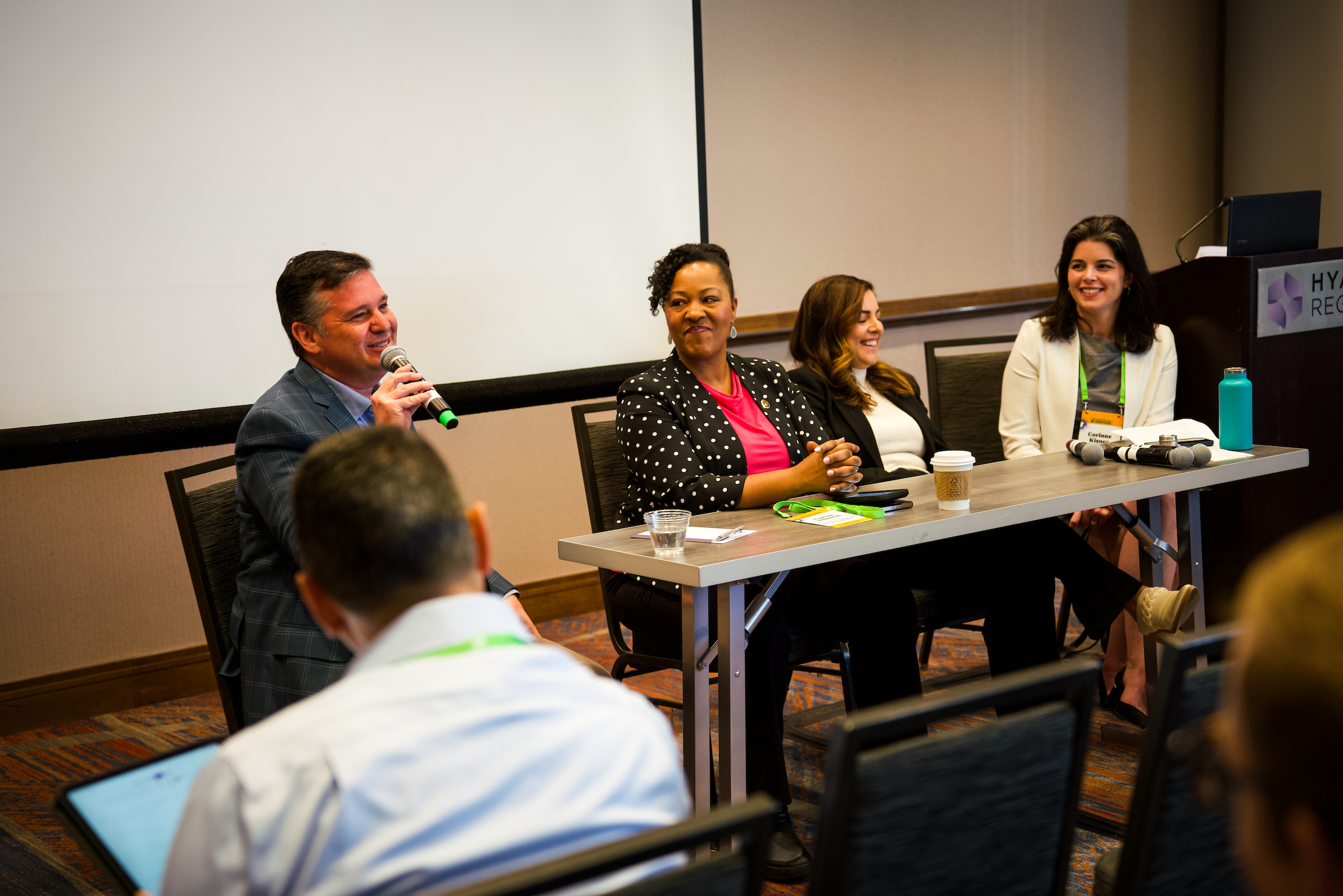“Conference Cliff Notes” is a series of short blog posts summarizing big takeaways and interesting ideas from NACTO’s 2023 Designing Cities Conference in Denver. You can read more about the conference here.

From left: Greg Spotts (Seattle DOT), Corren Johnson (Baltimore City DOT), Connie Llanos (LADOT), and Corrine Kisner (NACTO)
It’s a complicated time to lead a transportation agency. While staffers at every level play a crucial role in designing, maintaining, and improving our transportation systems, agency heads have a unique responsibility to define an agency’s vision, shape its organizational culture, and steer the ship through periods of tumult and uncertainty.
In recent years, that has meant grappling with a global pandemic that reshaped urban travel patterns; adapting streets to accommodate an ever-evolving spectrum of bikes, scooters and other mobility devices; and developing both short- and long-term responses to the intertwined crisis of traffic safety, climate change and inequality.
For agency heads just stepping into their role, that can be a lot to take on. How to demonstrate leadership in this complicated moment was the focus of “Taking the Wheel: Stories of New Leadership at Transportation Agencies,” a breakout session at the #NACTO2023 Designing Cities Conference, where three newly-appointed directors of Departments of Transportation across the U.S. shared their unique responses to the trends, challenges, and opportunities in transportation right now.
For these new leaders, staying grounded in an era of disruption and change has meant focusing on personal values. Those personal values, which can shape a director’s leadership style, priorities and worldview, are often informed by personal experience, explained Connie Llanos, Interim General Manager at the Los Angeles Department of Transportation. For Llanos, that has meant reflecting on her own family’s background and relationship to government.
“As a first-generation child of immigrants, you take on a role of having to parent your parents a little bit, because there are so many barriers to engaging for government,” Llanos said. “That shapes your thinking: how can you ensure there’s access for those who have lacked it, and create those points of connection and opportunity? Transportation is uniquely set up for us to do that.”
Translating those values and experiences into actionable transportation goals is the crux of the challenge facing agency leaders. While each of the new agency heads has years of professional experience and technical expertise, they know they can’t accomplish these goals alone. Instead, they must nimbly manage, delegate and empower agency staff, who often bring different types of knowledge and perspectives to the table.
“You don’t know it all, and sometimes that expertise is sometimes much deeper in the organization,” Llanos said. “Moments of fundamental shift and change require us to trust each other and be vulnerable.”
Greg Spotts, Director of the Seattle Department of Transportation, agreed, and explained that mutually trusting relationships between leadership and staff are especially important in moments of upheaval, something he experienced personally in the aftermath of the pandemic and the racial justice protests of 2020.
“Some of my staff have PTSD from the pandemic,” Spotts said. “I came in ready to try new things, but realized a moment of healing was needed. I always try to keep that in mind, the profound things people on the staff have been through.
“It always comes down to being an excellent public servant,” he continued. “Being calm, confident, and caring, and making people feel you have their best interests in mind.”

Building up trust means doing the difficult work of creating a cohesive, trusting agency culture that staff at all levels understand and buy into. Creating that internal culture can require leaders to act simultaneously on several different fronts, whether that means crafting a story and narrative about the agency’s goals, fighting to get staffers the resources and support they need to be successful, or even just engaging in one-on-one relationship-building.
“When I first started as an entry-level engineer, I was in a team that felt like a family,” said Corren Johnson, Director of the Baltimore Department of Transportation. “I cooked lunch for them when we wanted to celebrate early success. I’ve tried to keep that mindset. In a family, you may argue and disagree, but you still love and respect and work with each other. You come up with solutions and you move on.”
When an agency head can create that shared trust and buy-in amongst staff, it can also reshape the way the agency engages with the communities it serves. Ultimately, that can help ensure the agency is doing the best possible job of both recognizing community needs and advancing long-term goals.
“We’ve been in communities where we want to redesign a roadway to make it safer, and communities say, we’re not asking you for that: we want trees, or health care or a grocery store,” LLanos said. “Do we turn around and ignore that, or can we be agents for change? While also trying to move critical projects, because we’re facing crises of climate and safety. In the end, the north star has to be creating opportunities for people, and knowing both how you can help and how you can listen.”